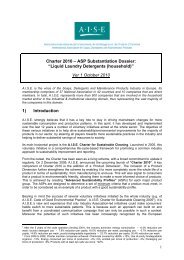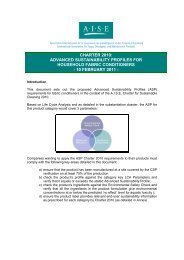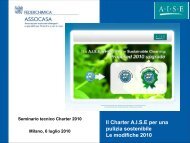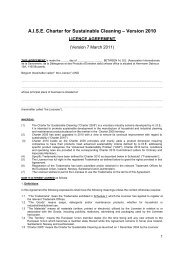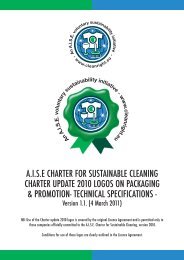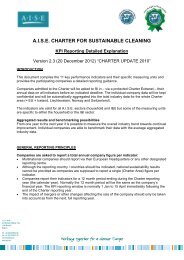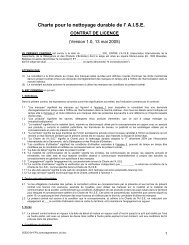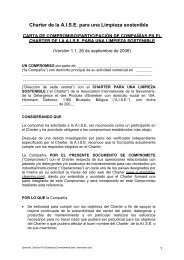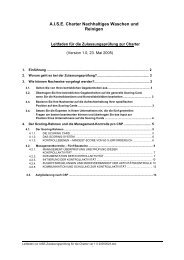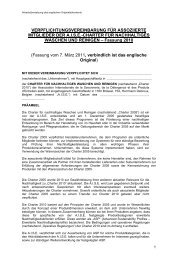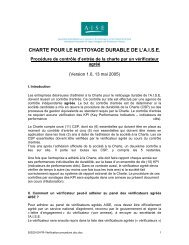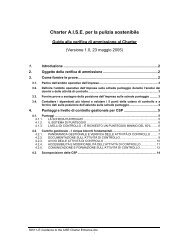2. Substantiation dossier - Sustainable Cleaning
2. Substantiation dossier - Sustainable Cleaning
2. Substantiation dossier - Sustainable Cleaning
You also want an ePaper? Increase the reach of your titles
YUMPU automatically turns print PDFs into web optimized ePapers that Google loves.
Product formulation<br />
Based on the outcome of the Life Cycle Analysis, the LCA experts identified the concentration of a<br />
product as one of the key factors, in order to reduce the environmental impact. Recognising that there<br />
is an opportunity to continue to extend the sustainability benefits with regard to the product<br />
formulation, the A.I.S.E. Sustainability Steering Group agreed that it would be appropriate to take<br />
another step towards. Building on the first Charter ASP for solid laundry detergents, which had been<br />
launched in July 2010 and for which a threshold for dosage had been set at 85g/135 ml, it is industry<br />
experts’ opinion, that a dosage of 75g/115ml appears now to be as setting a right balance between<br />
the aim to reach environmental savings and the possibility to achieve it through conventional<br />
technology available to all companies, including SMEs. The relevance of 75g/115ml per wash<br />
threshold was confirmed as one outcome of the consultation.<br />
Packaging<br />
Taking into account the outcome of the life-cycle analysis, packaging was identified as a further key<br />
factor, in order to reduce the environmental impact. In proportion to the decreased dosage threshold,<br />
a threshold of 6.5g for overall packaging per job has been proposed by industry experts. The<br />
threshold of 6.5 g per wash was confirmed as one outcome of the consultation.<br />
Packaging recycled / sustainably sourced content<br />
With regard to recycled content in packaging, a threshold of 60 % has been identified as still<br />
achievable by manufacturing companies, using conventional technologies yet leading to<br />
environmental benefit.<br />
As a further consultation outcome, a second option was added in order to fulfil this ASP criteria: the<br />
complete amount of packaging virgin board has to come from fibre sourced in a managed way, using<br />
certified forest content from an endorsed certification standard such as FSC, SFI or PEFC (FSC:<br />
Forest Stewardship Council; SFI: <strong>Sustainable</strong> Forestry Initiative; PEFC: Programme for the<br />
Endorsement of Forest Certification).<br />
End user Information<br />
As figured out in the life-cycle analysis, the most significant impact on the environment is in the use<br />
and disposal phases of the product’s life, due to the significant amounts of energy and water<br />
consumed by the washing machine.<br />
In April 2011, A.I.S.E. commissioned a consumer survey across more than 5,000 consumers in 23<br />
different countries about their current washing habits (a similar survey was run at the end of 2008).<br />
This survey showed that there is still significant progress to be achieved in the way consumers wash.<br />
For instance:<br />
- Only 56% of washing machine loads are full (compared to 49% in 2008).<br />
- The average wash temperature is 41.0°C (compared to 4<strong>2.</strong>6°C in 2008).<br />
- 32% of loads are washed at 30°C or lower (compared to 29% in 2008).<br />
- Only 69% of consumers indicate that they are aware of the dosing instructions (compared to 76% in<br />
2008).<br />
Considerable savings, both environmentally (water, energy, CO2, chemicals), and economic<br />
(financial savings for consumers due to correct dosing and efficient use of the appliance), could be<br />
reached through better sustainable consumer behaviour. In addition to formulating products that are<br />
compact and efficient at low temperature, it is also key to continue providing the consumers advice<br />
about wash parameters and correct dosage. Within this revised ASP criteria framework, companies<br />
are also be requested to use the Laundry Cleanright (former Washright) Panel, which had been<br />
introduced by A.I.S.E. in 1998 and revised in 2008 (see details in annex 2 of advanced sustainability<br />
profiles), and to indicate the ability to wash at ≤ 30° C on pack. Evidence has to be provided that the<br />
product has been performance tested and reached a level acceptable to consumers consistent with<br />
claims made. This was confirmed in the consultation.<br />
8



